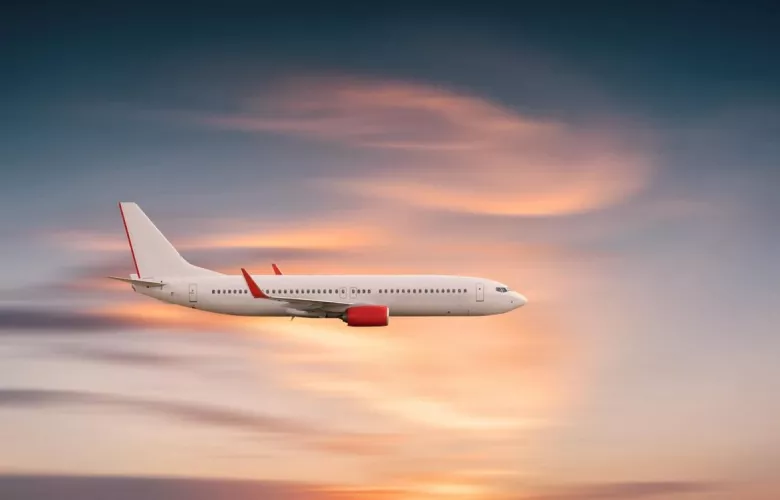
How Fast do Planes Fly: Commercial, Private & Military
The speed of an aircraft is a crucial aspect that influences travel time, fuel efficiency, and overall flight performance. Understanding these speeds can provide a fascinating insight into the realm of aviation.
On average, commercial planes cruise at about 575-600 mph (925-965 km/h, 500 to 521 knots, 0.78 to 0.81 Mach). Private jets typically cruise at around 500-600 mph (805-965 km/h, 435 to 521 knots, 0.68 to 0.81 Mach). Military aircraft can exceed 1,500 mph (2,400 km/h, 1,297 knots, 2.08 Mach).
As your dependable platform for in-depth and reliable aviation-related information, in this article, we'll be looking into the fascinating world of aircraft speeds, focusing on three main types: commercial planes, private jets, and military aircraft.
Note: If you've experienced flight delays, cancellations, or denied boarding in the United Kingdom, find out how you can claim compensation for your disrupted flight. Visit UK Flight Delay Compensation for expert advice and assistance.
Related: How Do Planes Have WiFi Up in the Air?
Disrupted flight? You might have a right to compensation - up to €600 ($650).Check Your Flight
How Fast Does a Commercial Plane Go?
Commercial aeroplanes are the backbone of global air travel, flying millions of passengers and countless tons of cargo across the world every day. Coming in an array of shapes and sizes, these aircraft handle different journeys efficiently and safely. From nimble regional jets that connect smaller cities to colossal long-haul aircraft capable of non-stop intercontinental flights, each type showcases impressive feats of engineering.
Speed, in particular, is a vital aspect of an aircraft's performance. It influences not only the duration of the flight but also the plane's fuel efficiency and the passenger's comfort. To give you a clearer idea of these speeds, we've compiled a table below that outlines the average cruising speeds of ten popular commercial aeroplane models:
Model | mph | km/h | Knots | Mach |
Boeing 787 Dreamliner | 652 | 1,049 | 567 | 0.86 |
Boeing 747 | 580 | 933 | 504 | 0.76 |
Airbus A380 | 561 | 903 | 487 | 0.74 |
Boeing 777 | 562 | 905 | 488 | 0.74 |
Airbus A340 | 541 | 871 | 470 | 0.71 |
Boeing 767 | 529 | 851 | 460 | 0.69 |
Boeing 737 | 523 | 842 | 454 | 0.68 |
Airbus A320 | 515 | 828 | 448 | 0.67 |
Embraer E190 | 515 | 828 | 447 | 0.67 |
ATR 72 | 317 | 510 | 275 | 0.41 |
How Fast Does a Commercial Plane Go During Take-Off?
Take-off is the phase of flight where an aircraft goes from ground to air. It's a complex process, reliant not just on the aircraft's powerful engines but also on the aerodynamic properties of its wings. As the aircraft accelerates along the runway, air pressure builds underneath its wings, generating lift. Once this lift counteracts the weight of the aircraft, the plane takes to the air, embarking on its journey.
It's important to note that an aircraft's take-off speed is not a constant figure but can vary significantly depending on several factors. The weight of the aircraft, the length of the runway, the wind conditions, and the ambient temperature can all impact the speed required for a successful take-off.
The speeds listed in the table below represent the average ranges of take-off speeds for various commercial aeroplanes:
Model | mph | km/h | Knots | Mach |
Boeing 787 Dreamliner | 160 - 185 | 257 - 298 | 139 - 161 | 0.21 - 0.24 |
Boeing 747 | 155 - 175 | 249 - 282 | 135 - 152 | 0.20 - 0.23 |
Airbus A380 | 155 - 165 | 249 - 266 | 135 - 143 | 0.20 - 0.22 |
Boeing 777 | 155 - 165 | 249 - 266 | 135 - 143 | 0.20 - 0.22 |
Airbus A340 | 155 - 165 | 249 - 266 | 135 - 143 | 0.20 - 0.22 |
Boeing 767 | 150 - 165 | 241 - 266 | 130 - 143 | 0.19 - 0.22 |
Boeing 737 | 150 - 155 | 241 - 249 | 130 - 135 | 0.19 - 0.20 |
Airbus A320 | 150 - 155 | 241 - 249 | 130 - 135 | 0.19 - 0.20 |
Embraer E190 | 140 - 150 | 225 - 241 | 122 - 130 | 0.18 - 0.19 |
ATR 72 | 105 - 120 | 169 - 193 | 91 - 104 | 0.14 - 0.16 |
How Fast Does a Private Jet Go?
Private jets are typically smaller aircraft primarily used for business or leisure travel, serving individuals or small groups who value speed, comfort, and flexibility. These planes often provide the luxury of direct flights to smaller airports, avoiding the crowded, hub-and-spoke systems of commercial airlines. Owned by corporations, affluent individuals, or chartered by those seeking quick and convenient travel, private jets offer an unrivalled level of service and efficiency.
While they may be smaller than commercial planes, private jets are often designed to cruise at high speeds, minimising the overall time spent in the air. This characteristic, coupled with their ability to provide a more seamless and luxurious travel experience, makes them highly desirable.
If your flight was delayed, canceled or overbooked within the last 3 years, you could be eligible for up to €600 ($650) in compensation.Check Your Flight
The table below outlines the general cruising speeds of some popular private jet models:
Model | mph | km/h | Knots | Mach |
Gulfstream G550 | 613 | 987 | 533 | 0.80 |
Cessna Citation X | 604 | 972 | 525 | 0.79 |
Bombardier Global 7500 | 593 | 955 | 515 | 0.78 |
Gulfstream G650ER | 594 | 956 | 516 | 0.78 |
Dassault Falcon 7X | 559 | 900 | 486 | 0.73 |
Bombardier Challenger 350 | 528 | 849 | 459 | 0.69 |
Dassault Falcon 2000 | 528 | 849 | 459 | 0.69 |
Embraer Phenom 300 | 521 | 839 | 452 | 0.68 |
Hawker Beechcraft 800XP | 515 | 828 | 448 | 0.67 |
Cessna Citation Latitude | 513 | 826 | 446 | 0.67 |
How Fast Does a Private Jet Go During Take-Off?
Take-off for private jets, much like commercial aircraft, involves a complex interplay between the aircraft's engines and its wings. Private jet take-off speeds, like those of commercial planes, are influenced by a myriad of factors, including aircraft weight, the condition of the runway and the temperature. Given these variables, there isn't a one-size-fits-all figure for take-off speed. Instead, each flight's take-off speed is carefully calculated based on these factors to ensure a safe and efficient departure.
Below, we've compiled a table of general take-off speeds for the same private jet models discussed earlier:
Model | mph | km/h | Knots | Mach |
Gulfstream G650ER | 155 | 249 | 135 | 0.20 |
Gulfstream G550 | 150 | 241 | 130 | 0.20 |
Bombardier Global 7500 | 130 | 209 | 113 | 0.17 |
Cessna Citation X | 120 | 193 | 104 | 0.16 |
Bombardier Challenger 350 | 115 | 185 | 100 | 0.15 |
Dassault Falcon 2000 | 110 | 177 | 96 | 0.15 |
Dassault Falcon 7X | 105 | 169 | 91 | 0.14 |
Hawker Beechcraft 800XP | 105 | 169 | 91 | 0.14 |
Cessna Citation Latitude | 100 | 161 | 87 | 0.13 |
Embraer Phenom 300 | 98 | 158 | 85 | 0.13 |
How Fast Does a Military Plane Go?
Military aircraft are designed and used for an array of combat and non-combat roles that include, but are not limited to, air superiority, ground attack, surveillance, transport, training, and rescue. These versatile machines are engineered to extreme specifications to withstand rigorous operations and carry out their missions effectively.
Speed is a critical element in the design of many military aircraft, with many models having extremely fast maximum speeds compared to commercial aircraft and private jets. For fighters and interceptors, speed often translates to survivability and mission success. For cargo and transport aircraft, speed can mean the difference between a timely delivery of troops or supplies and a failed mission.
Here's a table showcasing the average cruising speeds of some popular military aircraft:
Model | mph | km/h | Knots | Mach |
Lockheed Martin F-22 Raptor | 1,220 | 1,963 (supercruise) | 1,060 | 1.62 |
Dassault Rafale | 746 | 1,200 | 648 | 0.99 |
Sukhoi Su-27/30 | 674 | 1,085 | 586 | 0.89 |
Boeing F/A-18 Super Hornet | 643 | 1,034 | 559 | 0.85 |
Lockheed Martin F-35 Lightning II | 640 | 1,030 | 556 | 0.85 |
Mikoyan MiG-29 | 640 | 1,030 | 556 | 0.85 |
Northrop Grumman B-2 Spirit | 628 | 1,010 | 546 | 0.83 |
Lockheed Martin F-16 Fighting Falcon | 600 | 965 | 521 | 0.79 |
McDonnell Douglas F-15 Eagle | 570 | 917 | 496 | 0.75 |
Lockheed C-130 Hercules | 336 | 540 | 292 | 0.44 |
How Fast Does a Military Plane Go During Take-Off?
As with other types of aircraft, take-off speeds for military planes are not constant. In addition to being affected by various external factors like wind and runway length, military planes may have unique performance characteristics and higher or lower take-off speeds, depending on their specific design and role.
While precise data for each aircraft's take-off speed is often classified, below is a table with estimated take-off speeds for the same military aircraft models mentioned earlier:
Model | mph | km/h | Knots | Mach |
Lockheed Martin F-22 Raptor | 150 | 240 | 130 | 0.20 |
Sukhoi Su-27/30 | 150 | 240 | 130 | 0.20 |
Boeing F/A-18 Super Hornet | 150 | 240 | 130 | 0.20 |
Lockheed Martin F-35 Lightning II | 150 | 240 | 130 | 0.20 |
Mikoyan MiG-29 | 150 | 240 | 130 | 0.20 |
Northrop Grumman B-2 Spirit | 155 | 250 | 132 | 0.20 |
Lockheed Martin F-16 Fighting Falcon | 165 | 265 | 143 | 0.22 |
McDonnell Douglas F-15 Eagle | 160 | 257 | 139 | 0.21 |
Dassault Rafale | 138 | 222 | 120 | 0.18 |
Lockheed C-130 Hercules | 125 | 201 | 109 | 0.16 |
How Fast Are Planes Going When They Land?
When planes land, they’re moving considerably slower than their cruising speed. This slower pace, called landing speed, varies based on factors such as the aircraft's weight and the weather conditions. Below, you can find an example of the average landing speed for each of the types of aircraft discussed in this article:
- Boeing 737: the landing speed of this commercial aircraft is usually around 150 mph (241 km/h, 130 knots, 0.2 Mach).
- Cessna Citation X: this private jet might approach a runway at approximately 110 mph (177 km/h, 96 knots, 0.15 Mach).
- F-16 Falcon: this military aircraft generally lands at an average of 150 mph (241 km/h, 130 knots, 0.2 Mach).
Also read: When is the Perfect Time for Cheap Flights?
What Are the Factors That Influence a Plane’s Speed?
The speed of a plane is influenced by several factors, including its design, weight, engine power, and the weather conditions. The design and weight of the aircraft affect its ability to generate lift and maintain speed, while the engine power determines its thrust and acceleration capabilities. Pilots adjust the speed to ensure safety and compliance with regulations.
Claim with AirAdvisor and get up to €600 ($650) compensation. Find out how much you’re owed today.Check Your Flight
How is an Airplane’s Speed Measured?
Aeroplane speed is measured in knots, miles per hour (mph), or kilometres per hour (km/h). Different speed measurements include groundspeed (relative to the surface), true airspeed (relative to the air mass), and indicated airspeed (read from the speedometer, adjusted for altitude and temperature). At higher altitudes, speed is often referenced in terms of Mach numbers, representing the ratio of the aircraft's speed to the speed of sound.
Relared: Is the turbulence zone dangerous?
What’s the Fastest Plane Ever?
The North American X-15 holds the title of the fastest manned aircraft. The X-15 achieved a top speed of approximately 4,520 mph (7,273 km/h, 3,938 knots, 5.84 Mach). This experimental aircraft was specifically designed to explore hypersonic flight and set multiple speed and altitude records during its operational period from the late 1950s to the early 1970s. The X-15's remarkable achievements in pushing the boundaries of aerospace technology make it an iconic symbol of high-speed flight.
FAQs
Below you can find answers to FAQs about an aircraft's speed:
How fast can a single-engine aeroplane go?
The speed of a single-engine aircraft can vary depending on the specific model, but it typically ranges from around 115 to 230 mph (185 to 370 km/h, 100 to 200 knots, 0.15 to 0.30 Mach).
How slow can a plane fly?
The minimum speed at which a plane can fly, known as the stall speed, depends on factors such as aircraft weight, configuration, and atmospheric conditions, but it generally falls between 46 to 81 mph (74 to 130 km/h, 40 to 70 knots, 0.06 to 0.11 Mach).
Trending now: How Far in Advance to Book a Flight
No feedback
Leave your feedback
We don’t spam.

